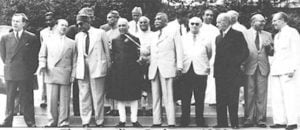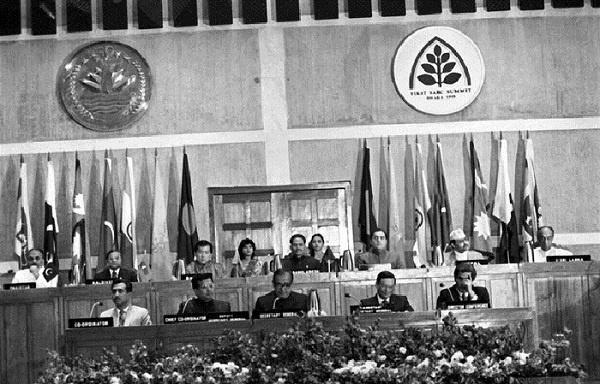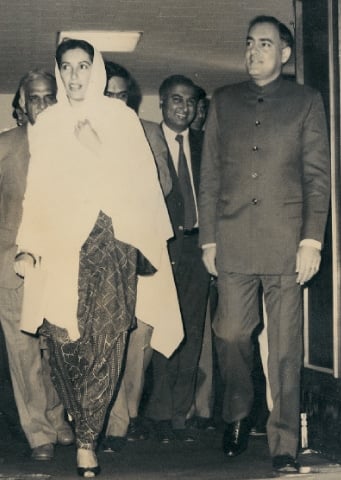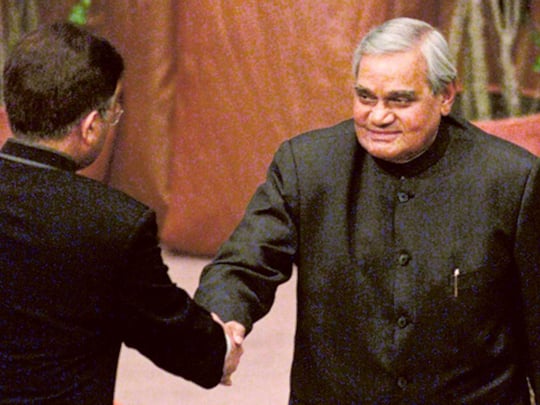The recent elections in Britain, France, and India are a reminder of the power of the people and also of the importance of regional cooperation. The Indian elections were the third electoral exercise in South Asia this year, after Bangladesh in January and Pakistan in February. Sri Lanka is also required to hold presidential elections before October.
As part of the democratic political process, elections determine the leadership that will shape not only a nation’s destiny but also that of closely connected regions. The governments may choose to be isolationist, follow the will of foreign powers, or cooperate and collaborate with neighbouring nations. Can and will South Asia’s regimes cooperate to promote regional peace, prosperity, and progress as they have done in previous decades, such as the 1950s, 1980s, and 2000s?
Such collaboration is essential for the sake of the people of the region.
Colombo Conference
The trajectory of South Asian regional cooperation began soon after World War II. The newly independent nations in the region—Sri Lanka (then Ceylon), India, and Pakistan (including then East Pakistan)—together with Indonesia and then Burma (now Myanmar) held a conference in Colombo from April 28–May 2, 1954. This initial attempt 70 years ago at addressing regional issues and promoting cooperation did not lead to a formal alliance, but it prepared the ground for the Non-Aligned Movement (NAM) of the 1960s.
That endeavour to preserve independence and neutrality during the Cold War years led to later diplomatic engagements in the region based on common concerns and interests. The Association of Southeast Asian Nations (ASEAN), established in 1967, showed the importance of regional groupings. However, it took almost 20 years for the idea to be implemented in South Asia, with the formation of the South Asian Association for Regional Cooperation (SAARC) in 1985.

Between the mid-1950s and mid-1970s, common post-colonial challenges around socio-economic issues pushed India and Pakistan, the region’s two largest countries, into aligning directly or indirectly with a Cold War superpower. Pakistan joined the US-backed Central Treaty Organization (CENTO), and the South East Asia Treaty Organization (SEATO). India remained a member of NAM but began to show more support for the USSR. This relationship was formalized with the 1971 Indo-Soviet Treaty of Friendship and Cooperation.
In the late 1970s, Indira Gandhi declared an “emergency” in India. Pakistan and Bangladesh had military coups. However, their regional policies had promise. Pakistan joined the NAM in 1979. India gradually returned to its initial stance of not allying with any superpower. Bangladesh, Sri Lanka, and other regional countries continued with inter-state dialogue.
Why SAARC?
For almost 40 years, SAARC, especially through its summits, has been crucial in bringing together countries in the region for policy initiatives and dialogue. Dialogue between the leaders of India and Pakistan during these summits has been crucial in fostering regional cooperation.

At the fourth SAARC summit in Islamabad, on December 29–31, 1988, an informal meeting between the prime ministers of India and Pakistan set the tone for the conference. Both leaders recognized the importance of promoting interpersonal relationships among their people and agreed to a special travel document for prominent citizens, exempting them from requiring visas. The SAARC Visa Exemption Scheme was officially launched in 1992.

| SAARC Summits | Policy Initiatives and Dialogue |
| Dhaka, 1985 | Resulted in a three-year MoU between India and Bangladesh on Ganges water-sharing. |
| Bangalore, 1986 | A meeting on the sidelines led to a peace agreement between India and Sri Lanka on the Tamil insurgency in 1987. |
| Islamabad, 1988 | Informal meeting set the tone for promoting interpersonal relationships, paving the way for the SAARC Visa Exemption Scheme launched in 1992. |
| Colombo, 1998 | First direct engagement between Indian prime minister and Pakistani president post-nuclear tests conducted by both countries |
| Kathmandu, 2002 | Handshake between Pakistani president and Indian prime minister restarted dialogue post-Kargil; SAARC Food Bank was also established. |
| Islamabad, 2004 | Decision taken to establish South Asian energy ring and enhance cooperation. |
| Dhaka, 2005 | Signing of SAARC Social Charter; Decision to establish SAARC Disaster Management Centre |
| New Delhi, 2007 | The Inter-governmental agreement for the Establishment of the South Asian University was signed. |
| Colombo, 2008 | Decision made to give each member state a lead position in regional projects. |
| Thimphu, 2010 | SAARC Development Fund established. |
The summit also agreed on the need to allow exchange schemes among researchers and academics. This led to an increase in people-to-people initiatives among both countries.
Short-lived
The bonhomie was short-lived. In May 1998, India and Pakistan tested nuclear weapons, leading to hostility. It was at a private meeting on the sidelines of the SAARC summit that their prime ministers engaged in person for the first time since the tests, in Colombo, on July 29–31, 1998. However, tensions rose again the following year with the Kargil “war-like situation.” The 11th SAARC summit was delayed by nearly four years. When it finally took place in Kathmandu in 2002, the famous handshake between the Pakistani president and India’s prime minister helped restart dialogue between the two nations.

Despite the numerous projects and initiatives that emerged from SAARC meetings, tensions between India and Pakistan have periodically negatively impacted regional cooperation and SAARC-related activities. For example, in 2016, India accused Pakistan of perpetrating the Uri attack which claimed the lives of several Indian soldiers. India refused to attend the SAARC summit in Islamabad that year. Bangladesh, Bhutan, and Afghanistan also later pulled out, citing security concerns.
During the 2000s, SAARC made significant strides in regional cooperation across ideological divides. The South Asian Free Trade Area (SAFTA) increased intra-regional trade by 22% annually from 2003 to 2008. The SAARC Disaster Management Centre enhanced disaster response, notably during the 2004 tsunami. The SAARC Development Goals helped improve health, education, and poverty reduction.
This November will mark a decade since the last SAARC summit was held in November 2014. In a study titled “What Kills International Organisations? When and Why International Organisations Terminate” (2020), Mette Eilstrup-Sangiovanni of the Department of Politics and International Studies at the University of Cambridge posits that an organization may be considered legally dead if it does not function for ten years or more. She bases her conclusion on a study of 561 intergovernmental organizations worldwide between 1815 and 2006. Of these, 345 had been discontinued. This may be SAARC’s fate if decisive action is not taken.
Blow Hot, Blow Cold
The COVID-19 pandemic catalyzed a brief revival of dialogue when India initiated a SAARC video conference in March 2020 in response to challenges faced within the region. While symbolically significant, the meeting did not lead to an official SAARC summit or strategy to tackle the pandemic.
Pakistan has, of late, attempted to improve relations with India. In May 2024, during a courtesy meeting with SAARC General Secretary Ambassador Golam Sarwar, Prime Minister Shehbaz Sharif reaffirmed Pakistan’s commitment to the principles and objectives of the SAARC Charter. Pakistan’s foreign minister, Bilawal Bhutto Zardari, travelled to India in 2023 for the Shanghai Cooperation Summit Foreign Ministers meeting. Political parties in Pakistan discussed the importance of a better relationship with India during their election campaigns earlier this year.

While India has not been forthcoming in its response, included within the manifestos of its two main political parties, the Bharatiya Janata Party and the Indian National Congress, were pledges to foster regional cooperation and develop better relations with its immediate neighbors. India has moved closer to the USA. It also focuses more on regional alliances that exclude Pakistan, like the Bay of Bengal Initiative for Multi-Sectoral Technical and Economic Cooperation (BIMSTEC), Bangladesh, Bhutan, India, Nepal Initiative (BBIN), and the Indian Ocean Rim Association (IORA).
Pakistan emphasizes closer connections with China and Muslim-majority nations in the region. Bangladesh and Sri Lanka have attempted to balance their relations with India and China. Today, the lack of regional cooperation in South Asia impedes development and has long-term negative economic, social, and security ramifications. Over-reliance on foreign powers for partnerships and financial support can have adverse economic effects as seen in Sri Lanka and Pakistan.
Regional cooperation makes sense geographically, socially, economically, culturally, and politically, as evident with the EU and ASEAN groupings and when SAARC was active. Coming together to collaborate and cooperate more frequently would result in a win-win situation for the whole South Asian region.
It is time for the region’s leadership to step up to this challenge.
This article was originally published in Sapan News.
If you want to submit your articles and/or research papers, please check the Submissions page.
The views and opinions expressed in this article/paper are the author’s own and do not necessarily reflect the editorial position of Paradigm Shift.



